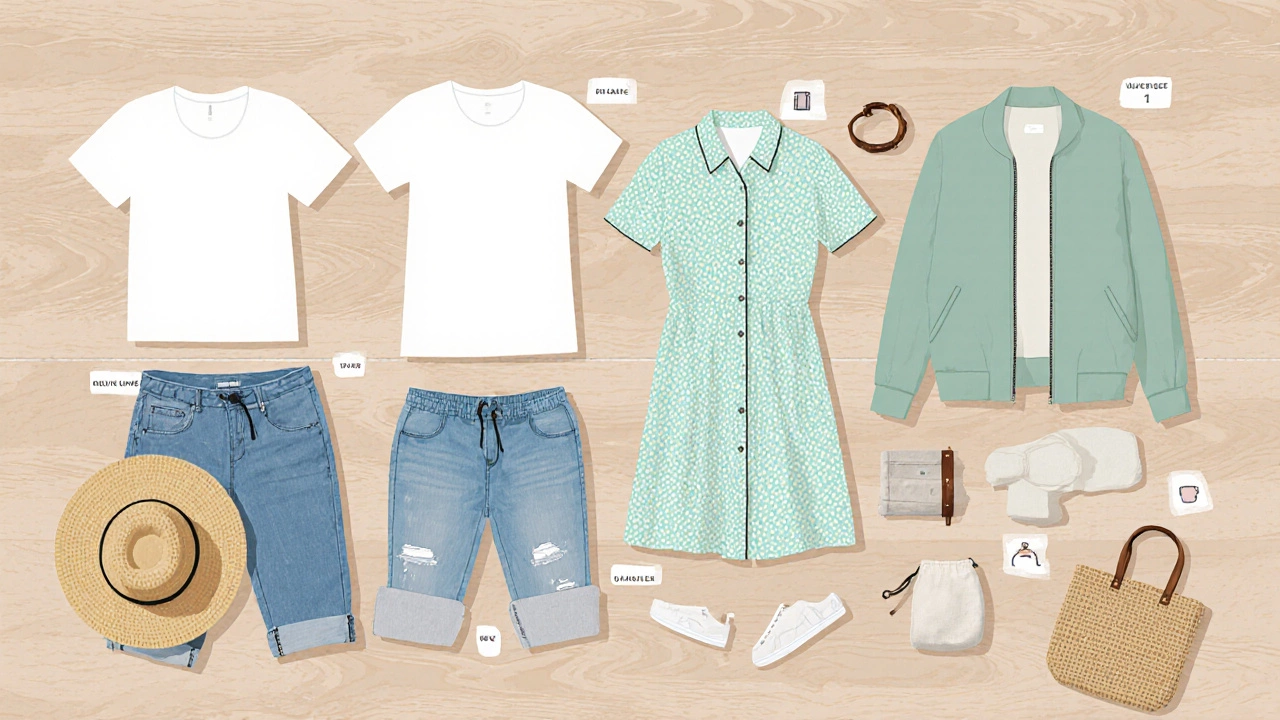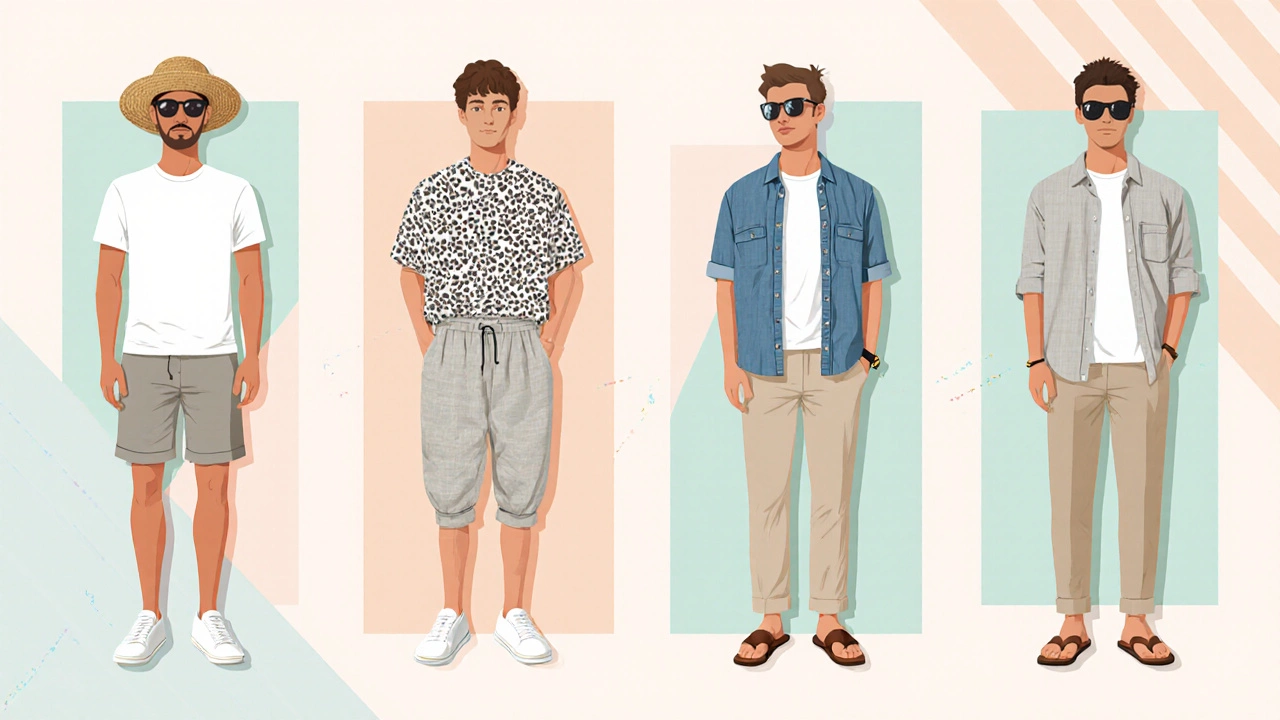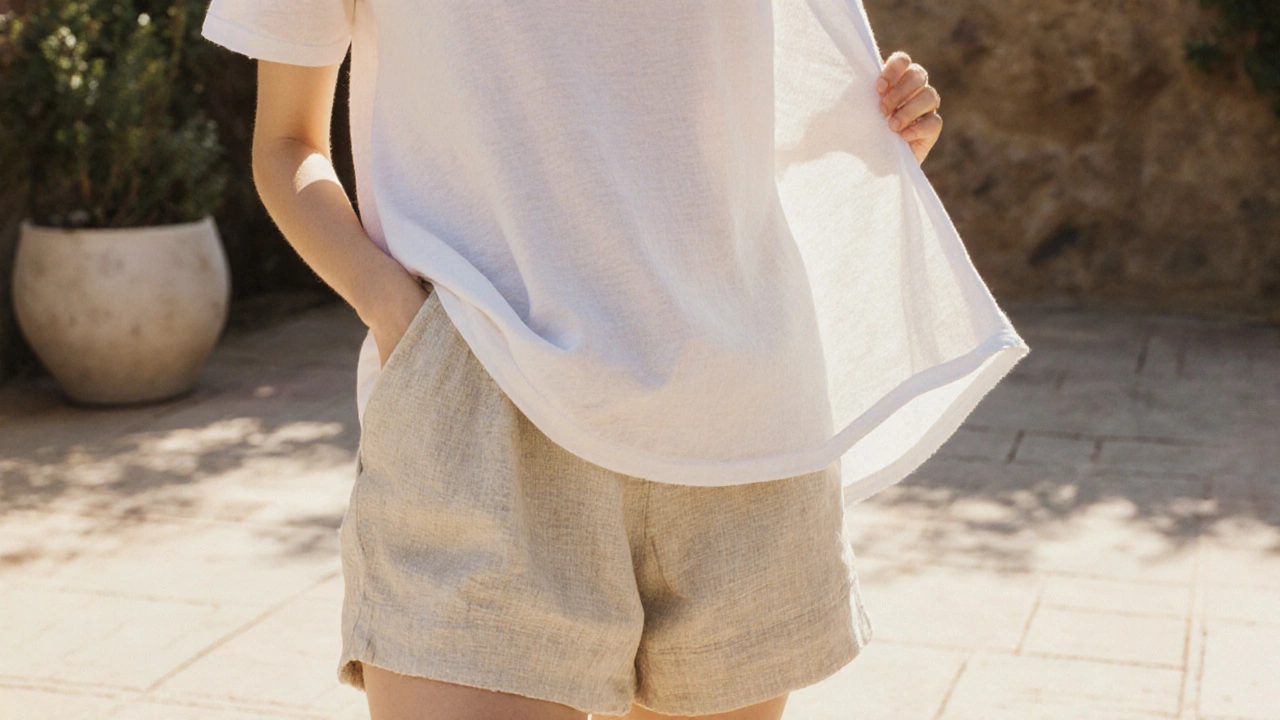Summer Fabric Selector
Recommended Fabric
Cotton
Soft, breathable, and absorbent. Great for everyday comfort.
Linen
Lightweight and naturally wrinkle-resistant. Trendy and relaxed.
Bamboo Blend
Moisture-wicking and eco-friendly. Ideal for active days.
Synthetic (Engineered)
High-performance moisture-wicking. Best for sporty looks.
When the temperature climbs, you don’t have to sacrifice style for comfort. Finding the sweet spot between looking good and staying cool is the real art of summer fashion is a style approach that balances comfort, climate suitability, and trendiness during warm months. Below you’ll learn practical ways to build outfits that feel breezy, look fresh, and still vibe with the latest trends.
Key Takeaways
- Prioritize breathable fabrics like cotton and linen.
- Stick to a light, cohesive color palette for easy mixing.
- Invest in versatile pieces that can be layered for cooler evenings.
- Choose accessories that protect you from the sun while adding personality.
- Opt for sustainable options to keep your wardrobe eco‑friendly.
1. Choose the Right Fabrics
Fabric choice can make or break an outfit on a hot day. Natural fibers let air flow, wick moisture, and stay breathable.
Cotton is a soft, breathable material that absorbs sweat and dries quickly, making it perfect for tees, shirts, and casual dresses. Look for lightweight weaves such as jersey or poplin to avoid added bulk.
Linen is a lightweight, loosely woven fabric that offers excellent airflow, giving you a relaxed, slightly wrinkled look that’s actually on-trend. Linen shorts, button‑downs, or jumpsuits become instant summer staples.
If you need a bit more structure, blends like cotton‑linen or bamboo‑cotton keep the breathability while reducing wrinkles.
| Fabric | Breathability | Moisture Wicking | Typical Use |
|---|---|---|---|
| Cotton | High | Good | T‑shirts, dresses, lightweight shirts |
| Linen | Very High | Moderate | Pants, jackets, jumpsuits |
| Bamboo Blend | High | Excellent | Undershirts, activewear |
| Synthetic (Polyester) | Low | Excellent (if engineered) | Performance gear, swimwear |
2. Build a Versatile Summer Wardrobe
Instead of buying dozens of pieces, focus on a core set that mixes and matches easily. Here’s a checklist:
- Two solid white or neutral tees.
- One patterned short‑sleeve button‑down.
- Two pairs of shorts (one denim, one cotton/linen).
- One lightweight summer dress (for women) or an overshirt (for men).
- One pair of breathable joggers for cooler evenings.
- A light, packable jacket.
With this capsule, you can create at least fifteen outfits by swapping tops, bottoms, and accessories.

3. Master Color & Pattern
Keep the palette light to reflect sunlight. Popular summer hues include soft pastels, muted earth tones, and classic whites. Using a limited palette makes mixing effortless.
Color palette is a selection of hues that work together, allowing you to pair pieces without clashing. Example: combine a pastel mint tee with beige shorts and a navy straw hat.
When it comes to patterns, go for subtle stripes, tiny florals, or small geometric prints. Pair a patterned top with solid bottoms to avoid visual overload.
4. Layer Smartly for Variable Weather
Even in summer, mornings and evenings can dip below 60°F (15°C). A lightweight outer layer helps you transition without overdressing.
Light jacket is a thin, breathable outer garment such as a denim shirt, bomber, or unlined blazer that adds warmth without trapping heat. Choose one with a relaxed fit so it can drape over tees comfortably.
Another layering trick is the “shirt‑over‑t‑shirt” combo: wear a short‑sleeve shirt over a graphic tee; you can roll up sleeves if it gets too warm.
5. Accessorize for Function & Flair
Accessories can protect you from the sun while upping style points.
Sun hat is a wide‑brimmed or cap style headwear that shields the face and neck from UV rays while adding a relaxed vibe. Materials like straw or breathable cotton work best.
A pair of sleek sunglasses with UV protection, a canvas tote for beach days, and a minimal leather or woven bracelet complete the look.

6. Footwear That Breathes
Feet sweat more in heat, so choose shoes that let air circulate.
Sandals are a open‑toed footwear option ranging from simple flip‑flops to strappy leather designs, ideal for keeping feet cool. For a slightly dressier vibe, go for leather slides with a cushioned footbed.
If you need more support for walking or festivals, lightweight canvas sneakers with perforated uppers are a great compromise.
7. Sustainable Choices Keep Summer Fresh
Eco‑friendly fabrics not only reduce environmental impact but often feel softer and more breathable.
Sustainable clothing is a range of garments made from organic, recycled, or low‑impact materials that minimize waste and chemical use. Look for labels like “organic cotton,” “Tencel,” or “recycled polyester.”
Investing in quality pieces that last multiple seasons beats buying cheap, disposable items that wear out after a few washes.
8. Quick Outfit Formulas You Can Grab
- Casual Day: White cotton tee + linen shorts + straw sun hat + sandals.
- Evening Chill: Patterned short‑sleeve shirt + breathable joggers + light jacket + canvas sneakers.
- Beach Ready: Oversized linen button‑down (worn open) + swim trunks + flip‑flops + sunglasses.
- Smart‑Casual: Light denim shirt over a solid tee + beige chinos + leather slides + minimal bracelet.
Now you have a toolbox of fabric knowledge, core pieces, and styling tricks to keep you looking sharp no matter how high the thermometer climbs. Remember, comfort fuels confidence, and confidence is the ultimate style statement.
Frequently Asked Questions
What fabrics should I avoid in summer?
Heavy synthetics like polyester jersey or thick denim trap heat and moisture, making you feel sticky. If you need performance wear, choose engineered moisture‑wicking variants that have ventilation panels.
How many colors are ideal for a summer wardrobe?
Stick to 3‑5 core hues-white, a soft pastel, a muted earth tone, plus one accent color. This keeps mixing effortless while still feeling fresh.
Can I wear shorts to a semi‑formal summer event?
Yes, choose tailored chino shorts in a neutral shade, pair with a crisp button‑down, and finish with loafers or sleek leather sandals. Keep accessories polished.
How do I protect my skin while staying stylish?
Wear UPF‑rated clothing, opt for wide‑brimmed hats, and always use sunscreen on exposed skin. Light fabrics with tighter weaves can also block some UV rays.
What’s the best way to pack for a summer vacation?
Roll your cotton and linen pieces to minimize wrinkles, use packing cubes for accessories, and place shoes in separate bags. Carry a lightweight scarf that can double as a cover‑up.

